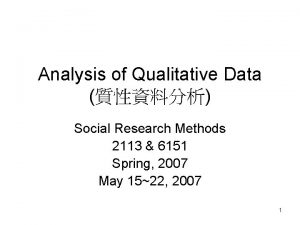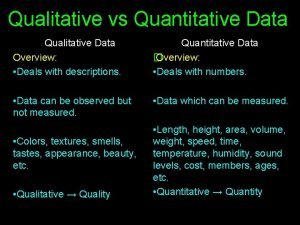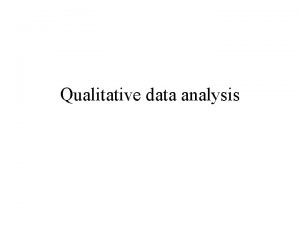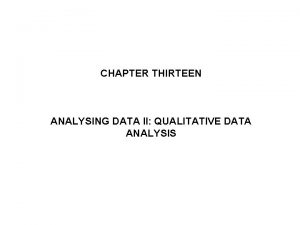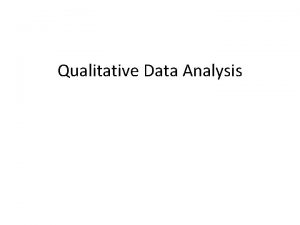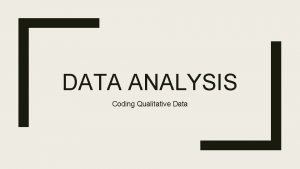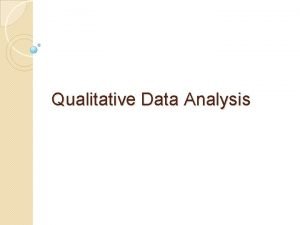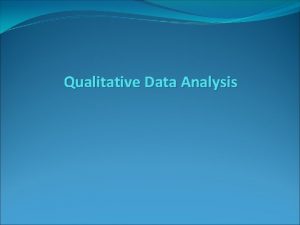Qualitative Data Analysis What is qualitative analysis n









- Slides: 9

Qualitative Data Analysis

What is qualitative analysis? n It is the non-numerical examination and interpretation of observations. n Theorizing and interwoven. n The primary activity of analysis is the search for patterns and explanations for those patterns. n The writing process itself is significant for structuring analysis are tightly

Some approaches to qualitative analysis n Grounded Theory – (Glaser and Strauss) – Begins with hypotheses observations and no preconceived – Seeks to discovers patterns in the data. n Semiotics – search for meaning generation of “signs” – (photos, particular dress i. e. baggy pants, phrases: “feminist”) – approach often used in content analysis (ads)

n Conversation Analysis – structure and norms around language and attached significance and meaning. – attention to pauses, tone, stuttering etc.

The Process n Data Collection and Transcription n Data Reduction – Coding – Memos n Anticipatory data reduction – decisions of what to ask and not ask n Concept Mapping (Data Displays) n Writing as analysis

Techniques of Coding n Color Coding n Writing n Word in Margins Processing Programs n Qualitative Data Analysis Programs

Recording and Managing Qualitative Data n Before data can be analyzed, they must be recorded and then gathered together into a form that makes analysis possible. n Data can be recorded in text form, by audio- or videotape, photographically, and by memory. n Each recording process has its advantages and disadvantages. n Sometimes sacrifice comprehensiveness and accuracy in favor of recording in a way that is least disruptive of participants.

n Managing qualitative data can be overwhelming at times. – As tapes, transcripts, and field notes accumulate, keeping track of everything can be daunting. n Making detailed lists of participants' pseudonyms, along with the dates of their interviews, the date transcription was completed, and so on will help keep your data orderly. n Create a file system early on so that you don't drown in piles of paper. n There is qualitative data analysis software.

Analyzing Qualitative Data n There are some generic strategies that are part of almost every approach to data analysis. – immersion in the data – doing preliminary and informal analysis – making analytic memos – finding codes or themes – connecting the codes or themes into categories – searching for confirming and disconfirming evidence – building a conceptual framework that explains the findings
 Quantitative data vs qualitative data comparison
Quantitative data vs qualitative data comparison Qualitative data quantitative data
Qualitative data quantitative data What is quantitative example
What is quantitative example Quantitative vs qualitative
Quantitative vs qualitative Principles of qualitative data analysis
Principles of qualitative data analysis Data analysis procedure in research
Data analysis procedure in research Qualitative coding examples
Qualitative coding examples What are the characteristics of quanlitative research
What are the characteristics of quanlitative research Quantitative research design example
Quantitative research design example Qualitative research
Qualitative research

